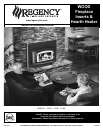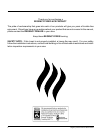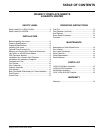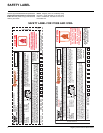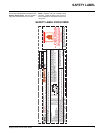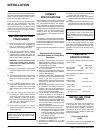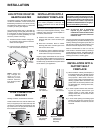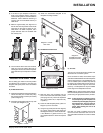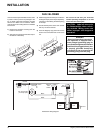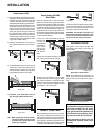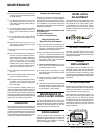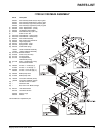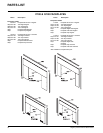
Regency Wood Insert & Hearth Heater8
1) Positive Flue
Connection
with Cleanout
FLUE CONNECTOR
BRACKET
Package contains: 3 brackets and 6 screws.
These brackets are to be used to hold the fl ue
liner (not supplied) to the Insert and keep the
connection. The brackets are screwed into the
top of the Insert in the pre-punched holes and
then screwed into the fl ue liner.
INSTALLATION
2) Direct Flue
Connection
with Cleanout
3a) Full Flue Liner
(No Cleanout
Required)
3b) Hearth Heater with
Full Flue Liner
(No Cleanout
Required)
Note: A clean-out door is sometimes
required, by your inspector, to be
installed when either the Positive fl ue
connection or Direct fl ue connection
method is used.
NOTE: Adding the
legs changes the
height of the unit,
make sure you have
sufficient clearance
(min. 28") for your fl ue
connection.
LEG OPTION ON H2100
HEARTH HEATER
The addition of legs to the Hearth Heater does
not alter its certifi cation, it does not become a
freestanding woodstove. The H2100 can only
be installed as a Hearth Heater i.e. vented into
a masonry or factory built fi replace.
The instructions below apply to the steel leg,
painted cast leg and the gold plated cast leg.
It will be easier to attach the legs to the stove
if it is tipped on its back (preferably on a soft
surface to prevent scratching).
1) Thread the bolt and washer through the
leg, and then into the nutsert in the base
of the stove and tighten.
2) Level the stove by adjusting the levelling
bolts in the bottom of each leg.
The use of one of the connection methods listed
on this page not only increases the safety of your
insert by directing the hot gases up the fl ue, but
will also help increase the unit's effi ciency and
decrease creosote deposits in the chimney.
When a connected fl ue or liner is in use, the
insert is able to “breathe” better by allowing a
greater draft to be created. The greater draft can
decrease problems such as, diffi cult start-ups,
smoking out the door, and dirty glass.
INSTALLATION INTO A
FACTORY BUILT
FIREPLACE
1) When installed in a factory built fi replace, a
full stainless steel rigid or fl exible fl ue liner
is mandatory, for both safety and perform-
ance purposes. When a fl ue or liner is in
use, the insert is able to breathe better by
allowing a greater draft to be created. The
greater draft can decrease problems such
as, diffi cult start-ups, smoking out the door,
and dirty glass.
2) In order to position the fl ue liner, the exist-
ing rain cap must be removed from your
chimney system. In most cases the fl ue
damper should also be removed to allow
passage of the liner.
3) In most cases opening the existing spark
screens fully should give enough room for
the insert installation. If it does not, remove
and store.
When referencing installation or connec-
tion to masonry fi replaces or chimneys, the
masonry construction must or shall be code
complying.
INSTALLATION INTO A
MASONRY FIREPLACE
The insert must be installed as per the require-
ments of your local inspection authority. Three
methods of fl ue connection are acceptable in
most areas, these include:
1) Positive fl ue connection, where a large
blocking plate and a short connector pipe
is used.
2) Direct fl ue connection, where a smaller
blocking plate and a connector pipe to the
fi rst fl ue liner tile is used.
3) Full fl ue liner, where a stainless steel rigid
or fl exible liner pipe is routed from the insert
outlet collar to the top of the chimney.
Regency highly recommends the use of a full
liner as the safest installation and provides the
most optimum performance. Your retailer should
be able to help you decide which system would
be the best for your application.
In Canada this fi replace insert must be in-
stalled with a continuous chimney liner of 6"
diameter extending from the fi replace insert
to the top of the chimney. The chimney liner
must conform to the Class 3 requirements
of CAN/ULC-S640, Standard for Lining Sys-
tems for New Masonry Chimneys.



